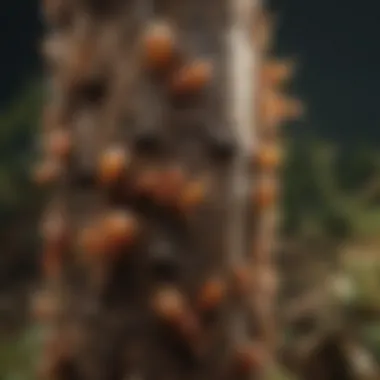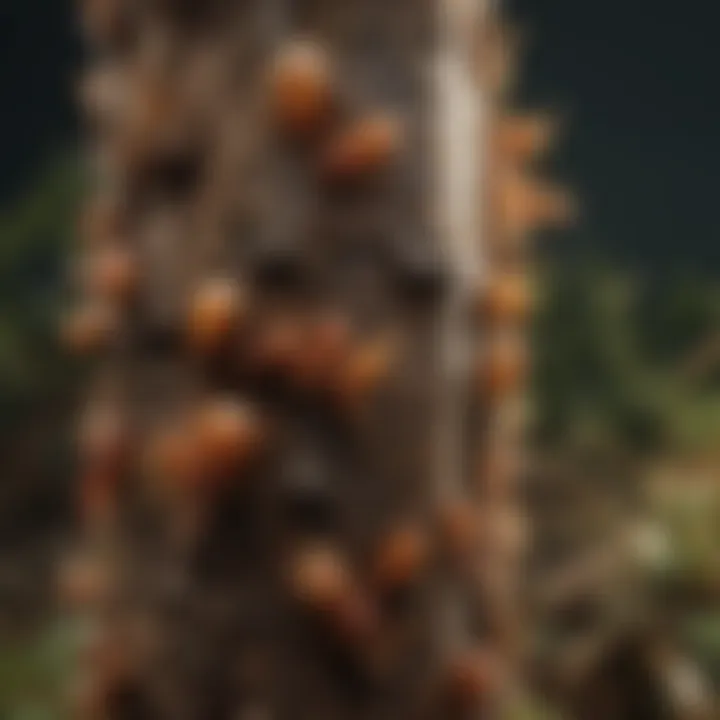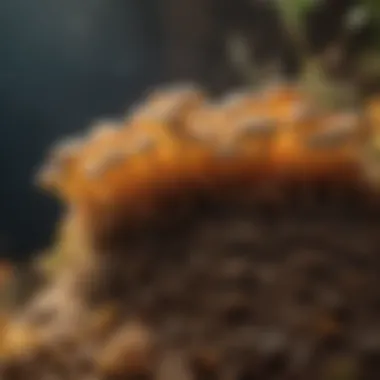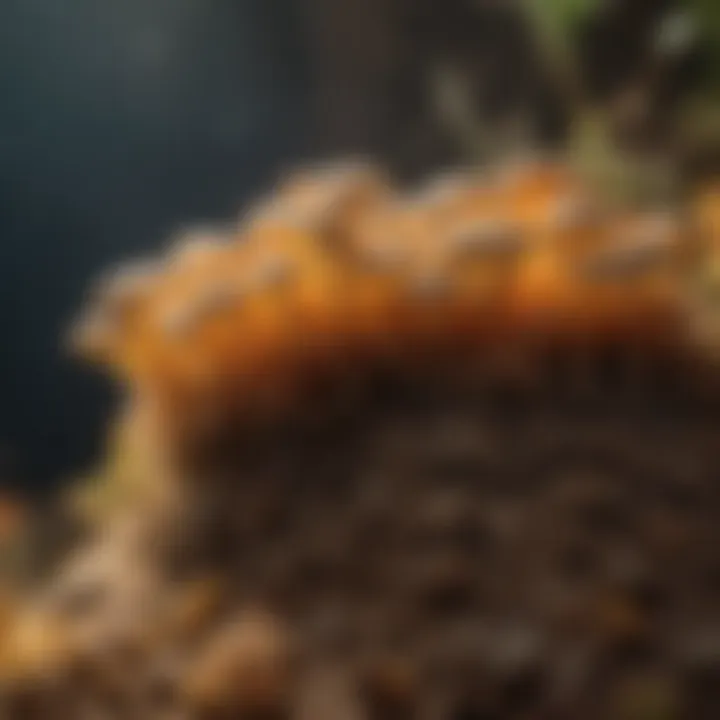Fungi in Termite Control: Efficacy and Strategies


Key Concepts and Terminology
Basic Definitions
Fungi are a vast group of organisms that include yeasts, molds, and mushrooms. They play crucial roles in various ecosystems, including nutrient cycling and decomposition. When it comes to pest management, certain fungal species exhibit antagonistic effects against termites, organisms known for their wood-destroying habits. Understanding the biological mechanisms by which fungi attack termites helps in devising effective control strategies.
Historical Context
The use of biological control methods dates back centuries. However, fungi have not always been recognized for their potential in termite control. Historical records indicate that various cultures have experimented with natural pest control methods. Recent research has reignited interest in this area, leading to new approaches that integrate fungi into pest management frameworks.
Recent Innovations and Trends
Technological Advancements
Recent advances in technology have paved the way for enhanced research on fungal applications in pest control. Molecular techniques, such as DNA barcoding, allow scientists to identify fungal species with greater accuracy. This specificity can lead to targeted pest management strategies that reduce harm to non-target species. Furthermore, biopesticides are being formulated from fungi that actively combat termite infestations, offering a viable alternative to chemical pesticides.
Sustainable Practices
Sustainable agriculture is more important than ever. Fungal solutions align with eco-friendly practices, benefiting both farmers and the environment. By utilizing fungi, practitioners can reduce reliance on synthetic chemicals, thereby minimizing the ecological footprint of agricultural activities. This method contributes to integrated pest management (IPM) strategies, promoting resilience in agricultural systems while maintaining productivity.
Practical Applications and Techniques
Step-by-step Guides
Implementing fungi in termite control involves several steps:
- Identification of Infestation: Assess the presence of termites in affected areas.
- Selection of Fungal Species: Choose specific fungi known for their effectiveness against termites, such as Beauveria bassiana or Metarhizium anisopliae.
- Application: Incorporate the selected fungi into the infested area, ensuring proper conditions for their growth and activity.
- Monitoring: Regularly check the effectiveness of the fungal treatment and make adjustments as necessary.
Case Studies
One notable example is the use of Beauveria bassiana in agricultural settings. Studies showed a significant reduction in termite activity in treated areas compared to controls. Additionally, research conducted in tropical forests demonstrated that fungal-pathogen interactions could naturally regulate termite populations, emphasizing the ecological roles fungi can play.
Fungal applications not only control pests but also integrate into broader ecosystem functions, maintaining soil health and promoting biodiversity.
Employing fungi for termite control opens avenues for sustainable pest management, which remains vital for modern agricultural practices.
Understanding Termites and Their Impact
Termites play a significant role in their ecosystems and agricultural settings. Understanding their behaviors and impacts is crucial in developing effective control strategies, particularly through fungal applications. Termites consume organic matter, particularly cellulose, contributing to nutrient cycling within their environments. This natural process can be beneficial; however, when termite populations surge, they can cause extensive structural and agricultural damage.
Recognizing the ecological role of termites provides insight into managing their populations. It helps inform which species can be targeted by fungi and the potential repercussions of such interventions. Furthermore, this understanding fosters a balanced approach to pest control, ensuring that beneficial or neutral species are not unduly affected. This balance is essential in sustainable agricultural practices, as it minimizes potential side effects and enhances the overall health of the ecosystem.
Ecological Role of Termites
Termites contribute significantly to soil health and ecosystem dynamics. They are primary decomposers of wood and plant materials, breaking down complex organic compounds into simpler forms. This process not only recycles nutrients but also enhances soil structure and aeration. Termites create tunnels that allow air and water to penetrate the soil, fostering a healthy environment for other organisms.
Additionally, their foraging behavior can promote the growth of specific plant species, thus influencing vegetation patterns in their habitats. Understanding these roles is critical when considering the introduction of fungal treatments for control. By applying fungal agents, one must ensure that the ecological balance is maintained and that only targeted species are affected, thereby preserving the regenerative capabilities of the ecosystem.
Economic Consequences of Infestations
The economic impact of termite infestations can be staggering. These pests are responsible for billions of dollars in damage annually, particularly in residential and commercial properties. Structures made of wood, such as homes and offices, are particularly vulnerable.
In agricultural contexts, termites can severely affect crop yields by damaging roots and stems. An infestation can result in significant financial losses for farmers due to reduced harvests and increased control costs. Understanding these impacts emphasizes the need for effective control measures, such as utilizing fungi, which offer a natural alternative to traditional chemical pesticides. This shift to biological control strategies can reduce financial burdens while maintaining sustainability in pest management practices.
"The integration of ecological understanding with fungal control methods can provide efficient solutions to pest management while preserving the environment."
By exploring the ecological roles and economic consequences of termites, we can better appreciate the importance of effective and sustainable pest control strategies, particularly those involving the use of fungi.
Overview of Fungal Biology
In understanding the role of fungi in termite control, it is crucial to grasp the foundational aspects of fungal biology. Fungi are not merely organisms; they are a diverse group of eukaryotic microbes with significant ecological functions. Their ability to thrive in various environments makes them important in agriculture, especially in pest management. This section will focus on two essential elements: the types of fungi relevant to pest control and their life cycles and reproduction.
Types of Fungi Relevant to Pest Control
Several fungal species have garnered attention for their efficacy in pest control. Understanding these types can help in selecting suitable candidates for termite management. Here are some significant groups of fungi:
- Entomopathogenic fungi: These fungi specifically target insects, including termites. They penetrate the insect's cuticle and disrupt normal biological functions.
- Beneficial fungi: Certain fungi, such as mycorrhizal fungi, enhance plant health that can indirectly affect pest populations. Healthy plants are generally more resistant to pests, including termites.
- Saprophytic fungi: These fungi decompose dead organic matter and can create an environment unfavorable for termite survival. Training compost or mulch with specific fungi can help in managing termite populations naturally.


Understanding the various types of fungi provides insight into how they can be employed in sustainable agricultural practices. It allows for a strategic approach in integrated pest management systems that emphasize ecological balance.
Life Cycle and Reproduction of Fungi
The life cycle of fungi plays a crucial role in their effectiveness as pest control agents. Generally, fungi exhibit a complex life cycle that includes several stages: spore production, germination, mycelium formation, and reproduction.
- Spore Production: Fungi release spores, which are their primary means of reproduction. These spores can survive harsh conditions and can remain dormant until favorable conditions arise.
- Germination: Under appropriate environmental conditions, spores germinate and develop into hyphae. These filamentous structures allow the fungi to invade and establish themselves within host organisms.
- Mycelium Formation: Mycelium, the vegetative part of fungi, grows and can spread widely, serving as the main means for nutrient absorption. In the case of entomopathogenic fungi, mycelium can grow inside the host and eventually lead to its death.
- Reproductive Structures: Fungi can reproduce sexually or asexually, producing various structures like fruiting bodies that generate spores. This flexibility in reproduction aids in their survival and reproductive success, enhancing their potential in pest control.
The fascinating life cycle of fungi is a vital consideration when implementing them as a biological control strategy against termites.
The comprehensive understanding of fungal biology, encompassing their types and life cycles, informs farmers and enthusiasts on how to effectively integrate fungal applications into pest management strategies. This knowledge ultimately aids in reducing reliance on chemical pesticides, thus fostering a more sustainable approach to agriculture.
Mechanisms of Fungal Action Against Termites
Fungi represent a compelling frontier in termite control strategies. Understanding how they operate against these destructive pests enables effective utilization and integration into pest management systems. The mechanisms of action primarily involve pathogenicity and feeding inhibition, both of which contribute significantly to controlling termite populations.
Pathogenic Fungi and Termite Mortality
Pathogenic fungi, such as Beauveria bassiana, infect and ultimately kill termites. The process begins when spores of the fungus land on the cuticle of a termite. The fungus secretes enzymes that break down the host’s protective layers. Once the cuticle is penetrated, the fungus colonizes the insect’s body, consuming its internal nutrients. This process leads to the incapacitation and death of the termite.
The transmission of these fungi can occur in various ways. For example, infected termites can potentially spread fungal spores to colony mates, creating a cascade of infections. This trait makes fungi particularly effective in controlling entire termite colonies. Research suggests that the mortality rate in treated populations can reach 90% or higher.
This highlights the importance of considering the use of pathogenic fungi as a biological control method. They provide a targeted approach against termites without damaging the surrounding ecosystem.
Inhibition of Termite Feeding
Another critical mechanism by which fungi exert control over termite populations involves feeding inhibition. Certain fungal species can disrupt the normal feeding behavior of termites. This inhibition can stem from fungal metabolites that affect the termites' gastrointestinal system or by physically altering the food texture and quality.
When termites encounter mycelium or fungal growth on wood or other potential food sources, they may avoid consuming those materials. This avoidance leads to starvation, significantly impacting the population density. The impact may not be immediate, but over time, it results in considerable reductions in termite numbers within an infested environment.
Incorporating this mechanism into pest control strategies can prove highly beneficial in integrated pest management. By using fungi to disrupt feeding habits, farmers can reduce reliance on chemical treatments, leading to more sustainable agricultural practices.
Understanding these mechanisms allows for a comprehensive approach to termite management using fungi and demonstrates the potential of biological controls as a viable strategy in agriculture.
Fungal Species Employed in Termite Control
The role of specific fungal species in termite control is not merely incidental; it is foundational for developing effective pest management strategies. Fungal agents operate through various mechanisms that disrupt termite behavior and promote mortality. Their application is gaining traction in integrated pest management due to their potential for sustainability and reduced environmental impact compared to traditional chemical insecticides. Identifying the most efficacious fungal species requires a nuanced understanding of their life cycles, modes of action, and ecological compatibility.
Fungi serve as biological control agents and provide several benefits:
- They offer an eco-friendly alternative to synthetic pesticides.
- Fungi can target specific pests, minimizing harm to non-target organisms.
- Low environmental toxicity enhances safety for humans and beneficial wildlife.
- They often possess unique mechanisms that prevent resistance development in pest populations, which is a growing concern in contemporary pest management.
Beauveria bassiana
Beauveria bassiana is one of the most well-studied entomopathogenic fungi. It is particularly known for its effectiveness against a wide range of insect pests, including termites. The fungus infects its host through a process called conidial adhesion, where spores adhere to the exoskeleton and penetrate through it.
The importance of Beauveria bassiana in termite control stems from its multifaceted approach:
- The fungus produces enzymes that degrade the termite's cuticle.
- It releases toxins that directly contribute to host mortality.
- The pathogen can persist in the environment, providing long-term control.
- It has shown effectiveness in various settings, making it a versatile option for farmers.
Research shows that this fungus can significantly reduce termite populations, thus aiding agricultural practices and protecting crops.
Metarhizium anisopliae
Metarhizium anisopliae is another significant fungal species in pest control. Its mechanism is similar to Beauveria bassiana, acting as a pathogen of insects. This fungus infects termites through similar methods of spore adhesion and cuticle penetration. Its adaptations to various conditions further enhance its usability in pest management.
Key considerations about Metarhizium anisopliae include:
- High virulence against several termite species.
- Ability to thrive in diverse environments, which broadens its applicability.
- Development of formulations that enhance spore viability and application efficiency.
- Evidence suggests synergistic effects when combined with other biological control agents.
Metarhizium anisopliae presents a robust option for farmers looking for an effective biological control method against termites, contributing to the sustainability of agricultural practices.
Entomophaga grylli
Entomophaga grylli, while primarily known for its effectiveness against crickets, also shows promise in termite control under specific conditions. This fungal species operates differently, primarily through direct infection and manipulation of host behavior. Although research on Entomophaga grylli concerning termite control is less extensive, initial findings indicate potential.
The attributes of Entomophaga grylli relevant to termite management include:
- Its ability to exploit specific behavioral traits of termites.
- The potential for application in integrated disease management strategies.
- Further studies could elucidate its ecological role and effectiveness across different environments.


Although Entomophaga grylli is not the primary choice for termite control, its inclusion in research could lead to emerging strategies in biological pest management.
The incorporation of various fungi in termite control signifies a shift towards ecological frameworks in pest management, reflecting a growing recognition of biological interactions and sustainability.
Fungi in Integrated Pest Management
Fungi have gained recognition as a fundamental element in Integrated Pest Management (IPM) strategies. This approach embraces a holistic view of pest control, combining multiple methods to attain sustainable outcomes. The integration of fungi fits well within this framework by offering both biocontrol options and environmental advantages.
One pivotal aspect of using fungi in IPM is their ability to naturally regulate pest populations. When combined with other pest management strategies, fungal treatments can enhance overall efficacy. This collaborative approach can involve chemical pesticides, mechanical methods, or even cultural practices such as crop rotation. Integrating fungi allows for a reduction in chemical inputs, aligning with ecological farming practices.
Here are some specific elements of combining fungal treatments with other methods:
- Reduced Chemical Dependency: Fungi minimize reliance on synthetic pesticides, lowering potential resistance development in pest populations.
- Ecosystem Compatibility: Fungal applications typically have less environmental impact than conventional methods. They can contribute to the health of surrounding flora and fauna.
- Enhanced Pest Suppression: When used alongside traditional methods, fungi can improve pest suppression rates, leading to better crop yields.
Combining Fungal Treatments with Other Strategies
Combining fungal treatments with other pest control strategies is essential for maximizing their potential. For instance, applying Beauveria bassiana alongside traditional insecticides can enhance mortality rates in termites. This synergy works as fungi can act on pests that have developed resistance to chemical treatments, providing an extra layer of control.
Moreover, cultural practices, such as altering planting times or diversifying crops, can complement fungal applications. By using different methods in tandem, farmers increase the odds of successful pest management, ensuring the sustainability of their practices.
Advantages of Biological Control
The shift toward biological control methods, particularly with fungi, offers several benefits that resonate well with modern agricultural practices. Utilizing fungi as biocontrol agents provides multiple advantages:
- Targeted Action: Many fungi specifically target pests without affecting other organisms, implying a high degree of safety for beneficial species.
- Sustainability: Biological controls generally align with sustainable development goals, reducing the long-term impact on ecosystems.
- Cost-Effectiveness: Although initial research and development can be costly, the long-term savings from reduced chemical usage can be significant.
"The application of biological control methods can lead to a more balanced ecosystem, resulting in healthier crops and increased biodiversity."
Methodologies for Fungal Application
In the quest for effective termite control, the methodologies for fungal application play a crucial role. As fungi offer a biological approach to pest management, understanding how to effectively harness their properties is essential. Effective methodologies can enhance the efficacy of fungal treatments while ensuring safety and sustainability. This section will explore the formulation of fungal treatments and the application techniques suited for different environments.
Formulating Fungal Treatments
The formulation of fungal treatments requires a deep understanding of the target fungus and its interactions with the ecosystem. Certain factors must be considered when developing these formulations. The strain of fungi selected can impact its effectiveness against termites. For instance, strains of Beauveria bassiana can vary in virulence, affecting how quickly and effectively they can eliminate termite populations.
The formulation must also consider the stability of the fungal spores. Environmental conditions such as humidity and temperature can degrade spores quickly. Therefore, using protective agents in the formulation can help maintain fungal viability until application. Additionally, carriers that can facilitate adhesion to the surfaces of wood or soil can improve fungal contact with termites, enhancing the likelihood of infection.
It's also important to consider the scale of treatment. For large infestations, a concentrated formulation may be necessary to ensure that a sufficient quantity of fungal spores reaches the termites. Conversely, for smaller infestations, a diluted version may suffice, provided the spores are still effective.
Application Techniques in Various Environments
The application techniques for fungal treatments differ significantly based on the environment in which they are used. For agricultural settings, soil incorporation is often the preferred method. This involves mixing fungal spores into the soil, allowing for direct contact with termites as they feed on the roots of plants. This method can also enhance the distribution of spores, ensuring more extensive coverage.
In urban settings or residential areas, spraying is a common application technique. Fungal solutions are mixed with water and applied using sprayers targeting specific areas where termite activity is noted. Attention should be given to ensuring even coverage, particularly in hard-to-reach areas like foundations or woodpiles.
When applying fungal treatments in forested or natural environments, aerial application can be effective. This method involves dispersing spores from above, ensuring a broad reach. However, challenges arise in this method, including ensuring spore viability and managing wind conditions.
Overall, careful consideration of the formulation and application techniques will enhance the effectiveness of fungal treatments.
Efficacy in fungal application depend not just on the fungus itself but also on how and where it is implemented.
By understanding these methodologies and applying them judiciously, agricultural professionals can leverage fungi as a powerful tool in integrated pest management.
Challenges in Fungal Termite Control
The use of fungi in controlling termite populations presents numerous challenges that must be considered for effective implementation. Understanding these challenges is crucial for professionals and enthusiasts alike who seek sustainable and biological pest management strategies. The adaptation of both fungi and termites in their respective environments can hinder the success of fungal treatments. Thus, it is vital to evaluate the multifaceted nature of these challenges to optimize the effectiveness of fungal applications in termite control.
Environmental Influences on Efficacy
Environmental factors significantly impact the efficacy of fungal treatments against termites. The presence of moisture, temperature, and soil composition can either enhance or impede fungal growth and activity. High humidity, for instance, creates an optimal environment for fungal spores, promoting their spread and infection rates among termite populations. Conversely, dry conditions can limit fungal application effectiveness.
Moreover, varying temperatures can affect the metabolic activity of both termites and fungi. Fungi thrive within certain temperature ranges, which may or may not align with the conditions required for termites. For example, extreme heat may stress termite colonies, causing them to alter their behaviors and evade fungal exposure.
Thus, applying fungi must be carefully timed and monitored to ensure maximum impact. Failure to consider such environmental influences can lead to suboptimal results in pest control efforts.
Resistance Development in Termite Populations


Another significant challenge in utilizing fungi for termite control is the potential for resistance development in termite populations. Just as with chemical pest control methods, over time, termites may adapt to the presence of fungal agents. This resistance arises from selective pressures placed on termite colonies, which can lead to genetic changes favoring survival despite fungal exposure.
Research suggests that repeated exposure to the same fungal species may encourage resilience among termites. When a population is consistently challenged by a particular strain, individuals that survive may pass their resistance traits onto progeny, gradually weakening the effectiveness of fungal treatments.
To counteract this resistance, it is advisable to rotate different fungal species and combine them with other pest management strategies. Employing varied approaches can reduce the likelihood of resistance development and maintain the long-term efficacy of fungal control methods.
"Understanding and addressing environmental influences and resistance development are essential for the successful application of fungi in termite control."
Regulatory and Safety Considerations
The regulatory and safety considerations surrounding the use of fungi for termite control are crucial in ensuring the efficacy and sustainability of this approach. As agriculture becomes increasingly reliant on integrated pest management strategies, understanding the compliance with agricultural practices and the implications for human and environmental safety is paramount.
Compliance with Agricultural Practices
Adhering to established regulations is vital for successful implementation of fungi in termite control. Compliance ensures that the farmers and agronomists using these methods understand their legal obligations while safeguarding the ecosystem. Regulatory bodies often set guidelines that dictate how biological agents, such as fungi, can be applied in various agricultural settings. These regulations help maintain the balance between effective pest control and the protection of non-target species and the environment.
Farmers must stay informed about local, regional, and national laws related to the application of biological agents. This may include:
- Registering specific fungal products with regulatory authorities
- Following recommended guidelines for application rates and timing
- Implementing proper storage and handling procedures to prevent contamination
Failing to comply with these practices can lead to unintended consequences like the disruption of local ecosystems or the development of resistance in pest populations.
Human and Environmental Safety
Safety concerns are at the forefront of discussions when utilizing fungi for pest control. It is crucial to assess any potential risks associated with fungi exposure for both applicators and consumers. Research has demonstrated that many fungal strains, like Beauveria bassiana and Metarhizium anisopliae, are generally safe for humans. However, it is essential to conduct thorough risk assessments to identify any potential allergens or pathogens that could pose dangers in certain circumstances.
Environmental safety also holds significant importance. The use of fungi should avoid harming beneficial organisms that contribute to soil health and plant growth. This calls for a comprehensive evaluation of environmental impacts, considering the following aspects:
- Effects on Non-Target Organisms: Ensure that the fungal agents do not adversely affect beneficial insects or other wildlife.
- Soil Health: Assess how fungal applications influence the microbial diversity and stability of soil ecosystems.
- Water Safety: Implement measures to prevent fungal runoff into water bodies that could disrupt aquatic life.
"Effective pest management is not just about controlling pests; it also involves protecting the environment and ensuring human safety."
By prioritizing these regulatory and safety considerations, stakeholders can enhance the effectiveness of fungi in termite control while aligning with sustainable agricultural practices.
Future Directions in Fungal Control Research
Research into fungal control for termites is vital. It offers innovative solutions to persistent pest issues. As traditional methods face challenges, the exploration of fungal applications becomes increasingly relevant. The shift towards sustainable practices aligns with ecological preservation and better pest management strategies.
Innovative Approaches and Technologies
The advancement of technology drives research into fungal applications. New techniques are arising that target fungal delivery systems. These systems can improve the effectiveness of fungal species against termites. For example, encapsulation methods can protect spores during application, ensuring they reach their target intact.
Another promising innovation is the utilization of genetic modification. Genetically altered fungi may exhibit enhanced pathogenicity. These strains can potentially overcome limitations seen in natural populations. Combining different fungal species could also enhance efficacy. This approach maximizes effectiveness while possibly reducing the chances of resistance development.
Field studies are crucial in evaluating the performance of these innovative methods. Understanding how variables such as weather, soil type, and climate impact fungal action can improve their application.
Potential for Commercial Applications
The commercial potential of fungi in termite control is significant. There is an increasing demand for environmentally friendly pest control solutions. As consumers show preference for sustainable practices, market opportunities arise for fungi-based products. Companies can develop biopesticides utilizing fungal strains like Beauveria bassiana. Such products can be integrated into existing pest management systems in agricultural settings.
In addition, partnerships between researchers and agricultural companies can foster development. These collaborations would facilitate the transition from laboratory to field applications, making the products viable for farmers. The regulatory landscape must also adapt to support these advancements. Clear guidelines can expedite approval processes, making innovations readily available.
"Fungal pest control methods represent a shift towards sustainable agriculture, catering to a growing market for eco-friendly solutions."
Furthermore, training programs can equip farmers with knowledge on how to use these innovative solutions effectively. Engaging the farming community is essential for successful implementation. Better awareness will help farmers understand the benefits and applications of fungal control methods in managing termite populations effectively.
Case Studies of Fungal Application in Field Settings
The exploration of case studies centered on the application of fungi in termite control is significant. These case studies not only showcase the practical aspects of implementing fungal treatments but also highlight the resultant effectiveness in real-world scenarios. Examining the successes and failures of various field applications provides valuable insights for agriculture professionals and enthusiasts. It also underscores the importance of understanding local conditions, fungal characteristics, and termite behaviors.
Successful Implementations
Several case studies stand out as examples of successful implementations of fungal agents in termite control. In a controlled study conducted in subtropical regions, Beauveria bassiana was applied to termite colonies. Researchers observed up to a 90% mortality rate in treated colonies within two weeks. This study highlighted how the application timing, environmental conditions, and proper formulation were critical.
Another successful instance occurred in plantation forests where Metarhizium anisopliae was introduced as a biological control agent. Here, the targeted delivery of spores to infected trees resulted in decreased termite activity, leading to better tree health and productivity. Key factors in this success included rigorous monitoring and adjustment of spore concentrations based on termite density.
It is noteworthy that in agricultural settings, the coupling of fungal agents with barriers or other pest management strategies yielded promising results. Farmers reported decreased infestations alongside increased crop yields after successive treatments.
Lessons Learned from Failed Attempts
Learning from failures is just as important as celebrating successes. In some cases, fungal treatments did not yield expected results. For instance, a project aimed at using Entomophaga grylli to control a massive termite invasion faced challenges due to environmental factors. Drought conditions led to moisture stress, which hindered fungal spore germination and effectiveness. This scenario emphasizes the need to consider climatic factors when planning fungal applications.
Furthermore, there were cases where lack of proper training led to misapplication. In one instance, field workers inadvertently used an inappropriate concentration of fungal spores. This resulted in disappointing outcomes, demonstrating why training is crucial for farmers and agricultural practitioners.
The effectiveness of fungal applications in pest control hinges significantly on proper understanding and execution in field settings.















